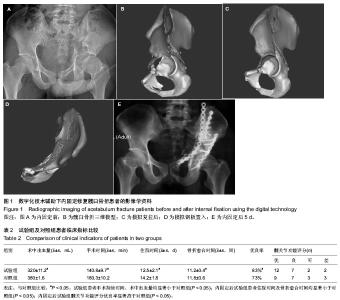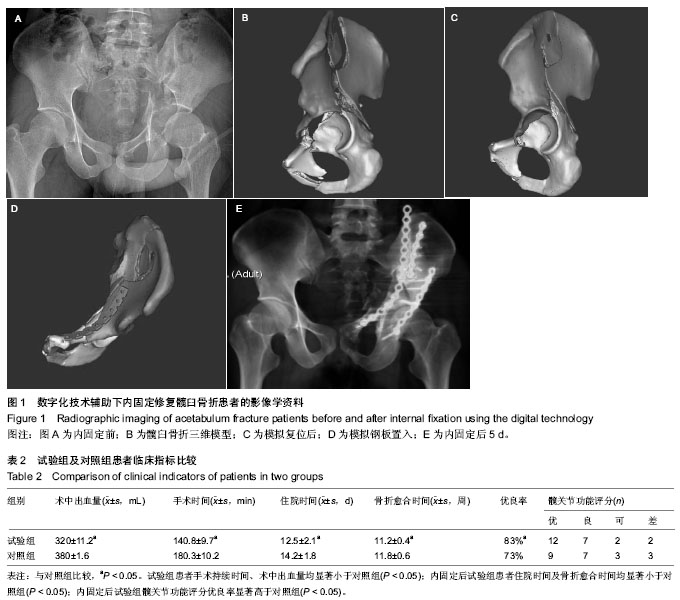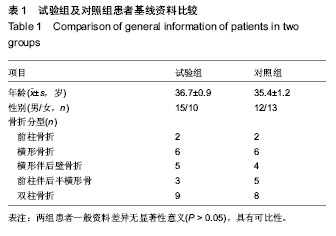| [1] Karunakar MA,Goulet JA,Mueller KL,et al.Operative treatment of unstable pediatric pelvis and acetabular fractures. J Pediatr Orthop. 2005;25:34-38.
[2] 赵海波,龙腾河,杨伟江,等. CT和有限元数字化骨盆模型构建的研究和临床应用[J].中国组织工程研究,2012,16(39): 7327-7332.
[3] Gabbe BJ, Esser M, Bucknill A, et al. The imaging and classification of severe pelvic ring fractures: Experiences from two level 1 trauma centres. Bone Joint J.2013; 95-B (10): 1396-1401.
[4] Gebhard F,Kinzl L,Arand M.Computer-assisted surgery. Unfallchirurg. 2000;103: 612-617.
[5] Radermacher K,Portheine F,Anton M,et al.Computer assisted orthopaedic surgery with image based individual templates. Clin Orthop Relat Res.1998;(354):28-38.
[6] Letournel E.Acetabulum fracture:classification and management. Clin Orthop. 1980;151: 81-106.
[7] 刘欣伟,商慧娟,王志伟,等.损伤控制原则在骨盆骨折合并大面积皮肤剥脱伤救治中的应用[J].中国骨与关节损伤杂志,2010, 25(6): 555-556.
[8] Matta JM.Fractures of the acetabulum:accuracy of reduction and clinical results in patients managed operatively within three weeks after the injury.J Bone Joint Surg(Am). 1996; 78(11):1632-1645.
[9] Matta JM, Merritt PO. Displaced acetabular fracture. Clin Orthop Relat Res.1988:83-97.
[10] Joskowicz L,Milgrom C,Simkin A,et al.FRACAS: a system for computer-aided image-guided long bone fracture surgery. Comput Aided Surg.1998;3:271-288.
[11] Cimerman M,Kristan A.Preoperative planning in pelvic and acetabular surgery: The value of advanced computerised planning modules.Injury. 2007;38: 442-449.
[12] Schatzker J,Tile M.The Rationale of Operative Fracture Care.3rded.Berlin Heidelberg: Springer-Verlag, 2005: 291-340.
[13] Wang MY, Williams S, Mummaneni PV, et al. Minimally Invasive Percutaneous Iliac Screws: Initial 24 Case Experience With CT Confirmation. J Spinal Disord Tech. 2012. [Epub ahead of print]
[14] Oberst M, Hauschild O, Konstantinidis L, et al. Effects of three-dimensional navigation on intraoperative management and early postoperative outcome after open reduction and internal fixation of displaced acetabular fractures. J Trauma Acute Care Surg.2012;73(4):950-956.
[15] Behrendt D, Mütze M, Steinke H,et al. Evaluation of 2D and 3D navigation for iliosacral screw fixation. Int J Comput Assist Radiol Surg. 2012;7(2):249-255.
[16] 台会平,刘杰,张辉,等.借助CT三维重建手术治疗陈旧性髋臼骨折疗效观察[J].临床骨科杂志,2010,13(6):623-625.
[17] Hurson C,Tansey A,O'Donnchadha B, et al.Rapid prototyping in the assessment,classification and preoperative planning of acetabular fractures. Injury. 2007;38:1158-1162.
[18] Whitmarsh T, Fritscher KD, Humbert L,et al. A statistical model of shape and bone mineral density distribution of the proximal femur for fracture risk assessment. Med Image Comput Comput Assist Interv. 2011;14(Pt 2):393-400.
[19] Luo Y, Ferdous Z, Leslie WD. A preliminary dual-energy X-ray absorptiometry-based finite element model for assessing osteoporotic hip fracture risk.Proc Inst Mech Engh.2011; 225(12):1188-1195.
[20] Brown GA, Firoozbakhsh K, Gehlert RJ. Three-dimensional CT modeling versus traditional radiology techniques in treatment of acetabular fractures. Iowa Orthop J.2001;21: 20-24.
[21] Xiaoxi J, Fang W, Dongmei W, et al. Superior border of the arcuate line: Three dimension reconstruction and digital measurements of the fixation route for pelvic and acetabular fractures. Int Orthop. 2013;37(5):889-897.
[22] 林锦乐,林壹冰,黄春育,等.计算机辅助复杂骨盆骨折手术治疗与疗效观察[J].长江大学学报,2011,8(1):146-148.
[23] 涂强,丁焕文,曹露,等.计算机辅助技术在复杂骨盆骨折诊断与治疗方面的应用[J].临床骨科杂志,2011,14(2):204-206.
[24] Starker M, Bischof F, Lindenfeld T. Total hip arthroplasty with shortening subtrochanteric osteotomy and custom-made prosthesis in Crowe type IV developmental dysplasia. Z Orthop Unfall. 2011;149(5):518-525.
[25] Nelson JD, Mclff TE, Moodie PG, et al Biomehchanical stability of intramedullay technique for fixation of joint depressed calcaneus fracture.Foot Anke Int. 2010;31(3): 229-235.
[26] Kamalian S, Hirsch AE, Growney ML, et al. CT guided percutaneous calcaneoplasty: a case of metastatic intra-articular calcaneus fracrure. J Neurointerv Surg.2009; 1(2):186-188.
[27] Zheng Z, Zhang Y, Hou Z, et al. The application of a computer-assisted thermoplastic membrane navigation system in screw fixation of the sacroiliac joint--a clinical study.Injury. 2012;43(4):495-499.
[28] Beldame J, Boisrenoult P, Beaufils P. Pin track induced fractures around computer-assisted TKA. Orthop Traumatol Surg Res. 2010;96(3):249-255.
[29] Wysocki RW, Sheinkop MB, Virkus WW, et al. Femoral fracture through a previous pin site after computer-assisted total knee arthroplasty. J Arthroplasty. 2008;23(3):462-465.
[30] Mahomed NN, Arndt DC,McGrory BJ, et al. The Harris hip score: comparison of patient self-report with surgeon assessment.J Arthroplasty.2001;16(5):575-580.
[31] 胡学峰,洪建明,刘敏,等.快速成型技术在骨盆髋臼骨折治疗中的应用研究[J].江西医学院学报,2007,47(5):56-58.
[32] Shen F, Chen B, Guo Q, et al. Augmented reality patient-specific plate design for pelvic and acetabular fracture surgery. J Int J Comput Assist Radiol Surg. 2013;8(2): 169-179. |



